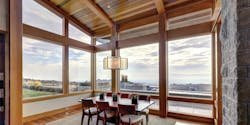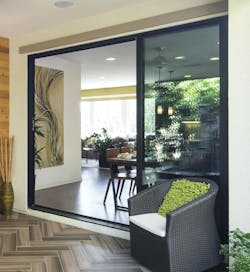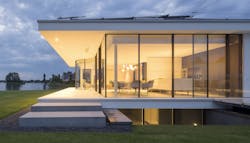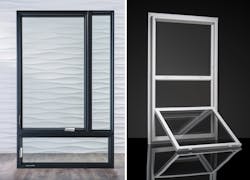Homeowners are paying closer attention to windows. According to the American Architectural Manufacturers Association (AAMA) 2016/2017 U.S. Industry Statistical Review and Forecast, the demand for windows improved by 3.1 percent in 2016, with overall demand for windows in new housing up by almost 5 percent in 2016. Increases of
7 and 8 percent are forecast for the next two years. With single-family housing starts continuing strong and predicted to rise by 10 percent in 2017, it’s worth exploring where consumers’ interests lie when it comes to windows.
In a tech-centric world, you may think benefit-packed technology features would be topping the list of attractors. But industry experts say that what consumers are focusing on is style because they see performance, durability, and energy efficiency all as a given.
MODERNIST MOVES
Consumers, it seems, are mad for modern. “Through the past five years, we have seen a significant increase in contemporary design popularity,” says Melissa Berger, associate product manager for Pella Corporation.“With sites like Houzz and Pinterest, trends are gaining momentum and becoming mainstream faster than ever,” she adds.
The style of a home often drives the choice of product types, with double-hung, casements, and direct-set windows continuing to be the most common types. Ease of maintenance, energy performance, and price are all variables that still drive style and material decisions, Berger says. “What we’re seeing [growing in popularity] across the country continues to be large expanses of glass, including minimal sight lines and frames.” Pella’s new Architect Series Contemporary line, launched in March 2017, for example, responds to those consumer preferences.
Curtis Gelotte, AIA, senior principal at Gelotte Hommas Architecture, in Bellevue, Wash., says, “About a third of our homes are contemporary, and sometimes the selection of the window manufacturer is what ensures a clean, crisp look both inside and out.”
“Homeowners are looking for more natural light, and contemporary designs expose more glass,” says Sean Smith, director of product marketing–vinyl and aluminum windows for Jeld-Wen Windows & Doors. “We’re also seeing more homeowners and designers recognize the impact that windows can have on a home’s overall design. Contemporary windows have a timeless quality that can blend with several different style choices and can adapt to interior updates.”
Marvin’s redesigned Ultimate Double Hung Next Generation window now locks at the center of the check rail instead of at each jamb. Original features, such as automatic locking and wash/tilt mode, remain.
BIGGER IS BETTER
Modern designs are influencing the size of windows, too. Chet Willis, VP of production builder sales for Western Window Systems, explains, “The shift to contemporary design is driving architects and designers to draw large, expansive openings. They want more glass to expand the viewing area and less frame to be seen.” Western Window Systems offers narrow-frame profiles, such as its Series 7000, offering big-window views in a system that can be specified in regions requiring enhanced energy performance and higher structural ratings.
Even traditional-style windows are getting an update. “We are seeing an increase in homeowners selecting a traditional-style window, such as a double hung, but in larger sizes with a narrow frame and dark colors, putting a modern twist on a classic design,” says Kris Hanson, senior manager of product management for Marvin Windows and Doors. The company’s Ultimate Double Hung Next Generation window is available in sizes up to 5 feet wide and 10 feet tall.
Transitional-style windows can get a modern boost with streamlined hardware. Marvin offers matte black hardware and a Designer Black window finish that projects an up-to-date aesthetic. Lance Premeau, market intelligence manager for Kolbe Windows & Doors, also notes that black window frame interiors and exteriors are experiencing a rise in popularity in transitional and contemporary designs.
The demand for larger windows and thinly framed vistas is a growing trend nationwide. “In years past, the Southwest region has been primary territory for our products,” explains Western Window Systems’ Willis. “However, in the past few years, we’ve seen an almost overwhelming shift in architecture to contemporary design. Our sales in other regions of the country have increased significantly, with heightened interest in the East and in the Midwest.”
STRENGTH AND DURABILITY
Elements that provide strength and durability are key in window design. Pella’s Berger comments that the most commonly used framing materials include wood with aluminum exteriors and vinyl. Jeld-Wen’s Smith notes that vinyl-framed products are most popular for their design flexibility, durability, anticipated low maintenance, and affordability. Cherie Nies-Cowgill, vice president of Nies Homes, in Wichita, Kan., likes Andersen’s 100 Series made with Fibrex, a composite low-maintenance material that’s twice as strong as vinyl, the manufacturer says. Marvin’s Hanson notes, “As the fiberglass industry continues to grow, homeowners are gravitating toward composite materials more often. They want to make sure that their investment will pay off in the long run, with an increased focus on quality and durability.” Marvin’s Integrity line is made with the company’s patented Ultrex pultruded fiberglass, making it eight times stronger than vinyl and three times stronger than vinyl/wood composites, according to Marvin. Kolbe Windows & Doors recently introduced the Forgent Series of windows made with Glastra, a proprietary hybrid of fiberglass and a UV-stable polymer.
Even wood frames today benefit from advanced technologies that increase weather resistance and durability. Jeld-Wen’s EpicVue contemporary clad-wood windows are made with AuraLast, a proprietary, water-based wood treatment that helps protect against water saturation, rot, and termites.
Arc curved sliding panels from Sky-Frame combine with rectilinear sliding panels to offer floor-to-ceiling views and expansive exterior vistas.
GETTING PERSONAL
The growing number of design options is propelled not only by what technology enables, but by consumers craving personalization. Premeau says it’s the Houzz factor. “People are seeing opportunities for customization,” he says. “They see the possibilities available and the opportunity to be more creative by partnering with manufacturers that are willing to provide solutions by collaborating with project teams.”
“Energy efficiency is always important, but it’s quickly becoming an expectation rather than a wish-list item for our customers,” Hanson says. Confidence that their windows will perform gives homeowners permission to focus more on how the window will fit the look of a project and how it will express their personal style, he adds. “The one-size-fits-all approach really doesn’t work anymore.” Says Berger, “The availability of artistic options is gaining importance.” Pella offers numerous choices, as well as the services of its Architectural Support Services division, which is comprised of engineers and drafters who work with architects and builders on their projects.
Designers and home builders are aggressively responding to buyers’ desires to blur indoor/outdoor distinctions, and windows play an integral part. According to Nic Neumann, COO of Sky-Frame, in Los Angeles, “Large casement windows or direct-glaze options offer homeowners new levels of unobstructed outside viewing.” Sky-Frame offers several types of floor-to-ceiling fixed and sliding panels: the rectilinear Classic, curved Arc options, and the Slope system with angled panels that have an inward or outward inclination. The sliding doors consist of glass units with aluminum or glass-fiber–reinforced plastic perimeter sections. The panels are mounted in aluminum frames fitted flush with the floor and ceiling and the drainage system runs via a recessed channel. Panels are offered in single, double-, and triple-glazed versions to meet a variety of thermal, wind, and sound-control requirements.
Pella Corporation’s Architect Series wood-frame casement window (left) features a black finish and polished chrome hardware. The 1620 Vinyl Single-Hung window from MI Windows and Doors (right) offers performance options such as metal-reinforced meeting rails, a true sloping sill, and heavy-duty weather stripping.
SPECIALTY WINDOWS
The market remains strong for skylights and specialty windows. The AAMA Industry Forecast reveals that residential skylight demand overall was up 4 percent in 2016 from 2015 volume, with skylight activity claiming a 10 percent increase. So-called horizontal windows are especially popular for kitchens and bathrooms. According to Ross Vandermark, national product manager at Velux America, “By shifting your natural light source from the walls to the ceiling, you can create more room for cabinets and storage.” He points out that in the bath, skylights offer added light without sacrificing privacy.
Today’s skylights have gone high-tech. “Intelligent touch remote-control and rain-sensing technology allow consumers to worry less about weather and simply enjoy their skylights,” Vandermark says. Solar-powered skylights and solar-powered blinds offer a smart way to save energy at home, he adds, and they’re easy for trades to install, as there’s no wiring required.
There is also a growing demand for privacy windows, which can serve several purposes. The windows can be used to admit light while obscuring the view inside; they can be used to bring daylight into previously non-windowed spaces from an adjacent room without compromising the intimacy of either space; and they can allow residents to enjoy daylight while obstructing an unsightly exterior view.
“There’s a trend right now of builders using smaller windows in a series of three to add diffused light and style to rooms throughout the home,” says Roger Murphy, president of Hy-Lite, a U.S. Block Windows Company, in Pensacola, Fla. “We’re seeing accent privacy windows installed in bedrooms, dining areas, stairwells, hallways, and family rooms to provide an intimate feeling, while enhancing the overall style of the home.” The new geometric Prairie design and tile-inspired ornate Baroque design from Hy-Lite are vinyl-frame 2-foot-square windows that are double-pane with tempered safety glass on the interior and exterior. The exterior glass includes the silk-screened privacy texture that admits natural light while preventing those outside the home from seeing in.
MUST-HAVES
Several must-haves are key considerations. “After design and affordability, homeowners focus on functionality, such as different types of glass, energy efficiency, and sound transmission,” Smith says. Post-recession, Hanson notices that consumers care more about value and are willing to pay more for quality products that will stand the test of time. Nies-Cowgill notes that the most popular windows are rectangular, clean-lined, and double paned with narrow frames, and are maintenance-free. “Everything is double pane, with the occasional triple pane,” says Gelotte, whose clients prize energy efficiency. “Sometimes this translates to a glazing package that exceeds the local energy codes,” he adds.
Aluminum-clad wood costs more than wood or vinyl windows, but they look great and are low-maintenance exteriors, he says. MI Windows and Doors offers the 1620 Vinyl Single-Hung windows that include operable archtop configurations, heavy-duty weather stripping, metal-reinforced meeting rails, a beveled exterior profile, tilt-in sashes, and mortised recessed locks, with an option to enhance performance in coastal areas and dual-pane glass packages that meet Energy Star requirements in North and South Central and Southern zones.




